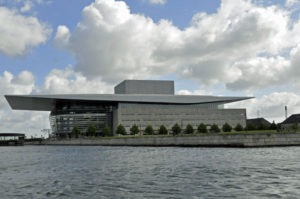
Opera House in Copenhagen, Denmark (Photo by Don Knebel)
In the late 1990s, Arnold Mærsk Mc-Kinney Møller, the billionaire owner of Mærsk, the world’s largest container shipping company, thought his home city of Copenhagen needed a symbol. He proposed constructing an opera house on a man-made island in Copenhagen’s harbor and donating the building to the government. The island, near Mærsk’s waterfront headquarters, is directly across from Amalienborg, the historic home of Denmark’s royal family. Although many citizens of Copenhagen vigorously opposed the opera house because of its location and because of its enormous tax benefit to Mærsk Mc-Kinney Møller, the government approved the idea.
Mærsk Mc-Kinney Møller hired 75-year-old Henning Larsen, a Danish architect whose mentor had designed the iconic opera house in Sydney, Australia. Mærsk Mc-Kinney Møller dictated some of the design elements, including adding metal to the curved entry. When completed in 2004, Copenhagen’s new 450,000-square-feet opera house included 1000 rooms spread among fourteen stories, five of them underground. The ceiling of the foyer was covered with more than three pounds of gold leaf. The total cost of the building was about $500,000,000, or more than $300,000 for each of the approximately 1400 seats in the main auditorium.
Despite (or perhaps because of) its enormous cost, the building’s design has been widely lampooned, described variously as a fly, an oil can and a space ship. The glass and metal entry has been compared unfavorably to the grill of a 1955 Pontiac. The curved maple wall at the rear of the foyer, stained orange to suggest a violin, is known locally as the “giant pumpkin.” Even architect Larsen, who acknowledged the building as his “greatest failure,” thought it looked like a toaster.
Comments are closed.